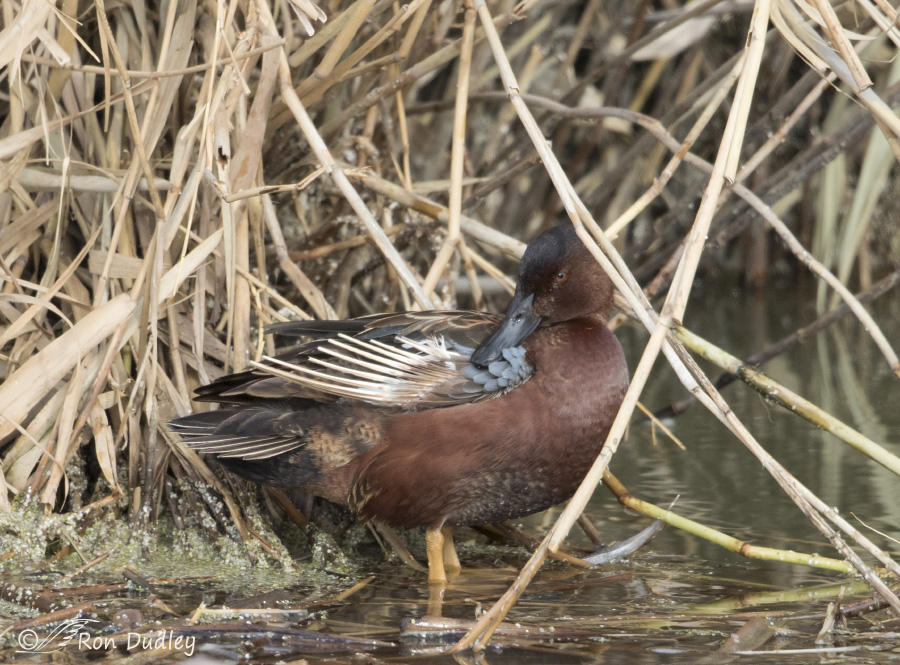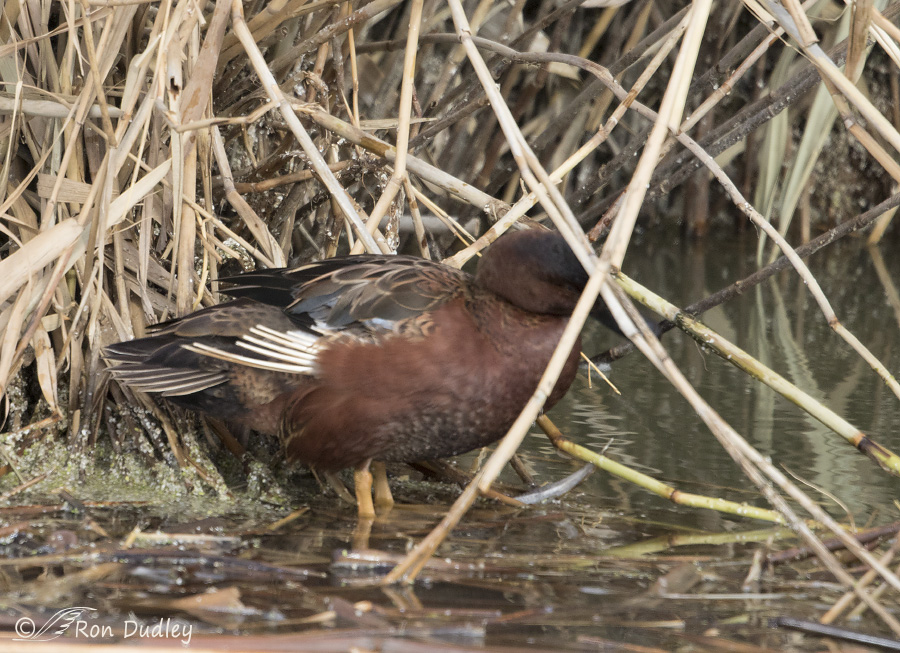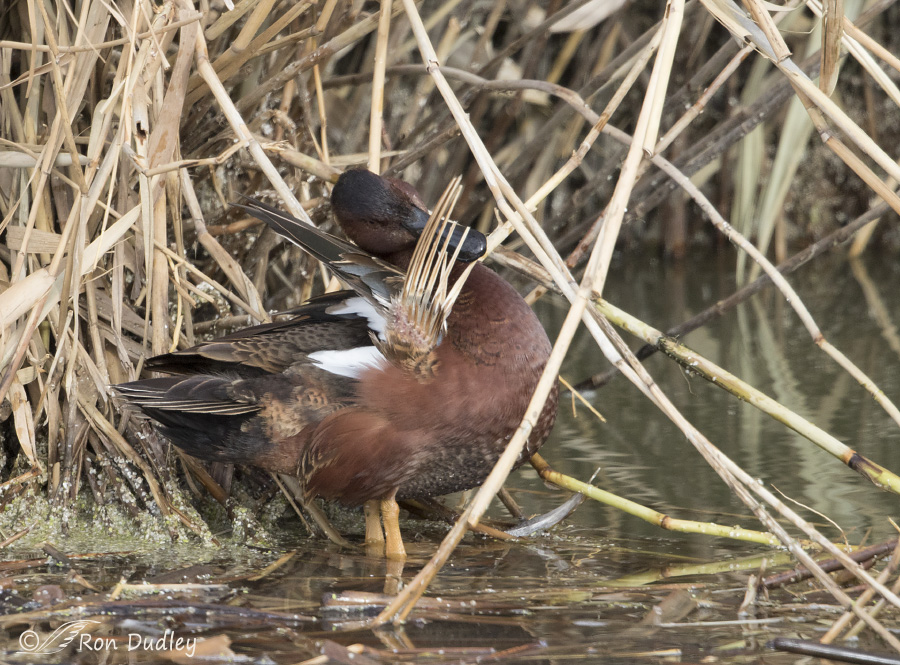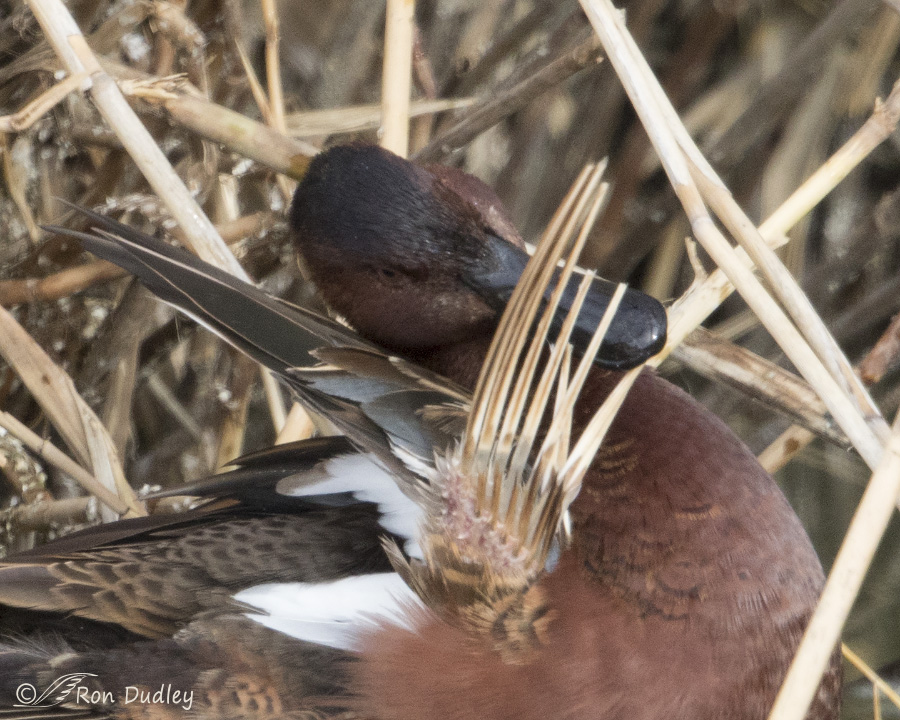Ok, curiosity finally dictated that I post some images of this duck. Does anyone know what’s going on here?

1/640, f/5.6, ISO 800, Canon 7D Mark II, Canon EF 500mm f/4L IS II USM + 1.4 tc, not baited, set up or called in
I photographed this male Cinnamon Teal 10 days ago at Farmington Bay WMA as he groomed against the far bank of the 4-way pond. As soon as I trained my lens on him I noticed that very unusual looking right wing. It appears that all that is left of the primary flight feathers there is stubs of the quills and shafts – the vanes (including barbs, barbules and hooks) of those feathers are not present, not even any remnants of them.

1/800, f/5.6, ISO 800, Canon 7D Mark II, Canon EF 500mm f/4L IS II USM + 1.4 tc, not baited, set up or called in
This is what the wing looks like when it’s held in a near-normal resting position. Sorry about the softness of the image but it’s the only one I have with the wing in this position.

1/640, f/5.6, ISO 800, Canon 7D Mark II, Canon EF 500mm f/4L IS II USM + 1.4 tc, not baited, set up or called in
The bird was grooming for most of the time I was photographing him and he spent much of his time working over that right wing. Perhaps its own (abnormal?) grooming activities caused this condition. I’ve also considered feather mites or lice but to my untrained eye this looks like something very different.

A huge crop of the previous image shows the quills all the way down to their insertion into the skin but it still gives me no clue as to what’s going on, though the activity of the duck with the tip of one damaged shaft in its bill makes me wonder if that activity could be responsible for the condition. On the other hand the bird may be preening in response to the condition rather than causing it.
My readers range from bird lovers with a lot of expertise, to rehabbers, to folks with significant scientific background to very knowledgeable birders so I’m hoping that someone out there might be able to provide at least an educated guess as to the cause of this condition.
I just hope I haven’t missed something simple, routine and/or obvious…
Ron
PS – Sorry about the tardy post this morning. Bluehost was down so I couldn’t publish. “Technical difficulties” are a pain in the butt, though I suppose they come with the territory…


Sorry this took a while, but I heard back from Matt Klar, my vet/falconer friend in Utah (maybe the Park City area, but do NOT quote me on that!). He said, “fire or featherpicking would be the only things I can think of that would strip the barbs off the rachis like that. there’s a plant (can’t remember the name) that will twist their barbs into dreadlocks and they’ll strip them off via grooming (Dalyn has a PEFA now that did exactly that).”
I followed up questioning about that plant and how THAT works. I’ve never heard of that happening, but there are always those things I don’t know 😀
If you’re anywhere near that area, and if you’re interested, I can hook you two up for a falconry adventure. He’s flying two Harris’ hawks and he and his daughter are now working with a new passage redtail who’s ALMOST ready for hunting.
This summer I watched a Sea Eagle cam in Australia. There were 2 babies and both appeared to be growing normally until fledge time came. The youngest fledged with no problem, the second one would flap and flap and get nowhere. One day he decided to take a chance and he just fluttered right to the ground. His wing feathers just didn’t look normal. He was taken to a rehab and after weeks of testing they said his feathers wold never come in normal. They said it was genetic. They are going to keep him as a teaching bird. I feel so bad for this duck. He really needs to be protected.
I know you have a lot on your mind, but I hope you have a Happy Christmas. I am still praying for your daughter and I pray for a tiny improvement each day.
has anyone tried to rescue it? It does have flight ability very obviously and how is it going to survive the winter?
“has anyone tried to rescue it?”
Not that I know of, Christy. These photos were taken 10 days ago and I haven’t seen the bird there since.
I’m not sure why you would say it has “flight ability very obviously”…?
I was expressing my concern and the fact that obviously it doesn’t have flight capability my keys stick!!
Oh, ok, makes sense now. I have that key-sticking problem sometimes too. I’ve bought more new keyboards than I like to admit. Good thing they’re cheap…
I agree! 🙂 I love animals and nature greatly and feel for this duck wonder what happened to it? where was it?
Interesting observation and shots Ron! Hope he makes it to recovery.
Charlotte
Thanks, Charlotte.
A friend, Dillon Horger, who has worked with birds for many years said. “Super strange. If it were spring or summer, I would definitely say it was just an ordinary molt, since waterfowl drop all of their primaries at once. My best guess would be that it was grabbed on the wing by a predator and lost all the feathers on that wing and they are growing back in now all at once. It doesn’t look like a sickness or parasite I’m familiar with, although Avian flu does cause some strange stuff to happen…”
Hope you get an answer soon.
Caroll, thanks for relating Dillon’s comments. Possible predator damage isn’t something I seriously considered but it looks like maybe I should have.
How interesting! I wonder if it’s a genetic condition. I know this is a totally different setting and kind of a bird, but once on Kauai, we found a juvenile Red-footed Booby who couldn’t fledge due to abnormal flight feathers. His flight feathers only consisted of the rachis and barbs, but were missing the barbules and hooks that make up the vane, and therefore couldn’t fly. Our rehabber determined it was probably genetic. It was sad because the bird seemed perfectly healthy and normal otherwise.
Hi, Megan – so good to hear from you.
I also wondered if it was genetic – so many possibilities…
Sad. And bad.
Yep, life will likely be tough for this duck, EC.
Now you have peaked the interest of all the rehabers, but without the bird in hand ( and sometimes even then) it is hard to tell why it has feather or follical damage. I’d say Mikal Deese has it right.
Sorry I real need to re-read my post before I hit enter. I can spell but sometimes my brain is too far ahead of the hand and funky spellings appear.
Follicle. Maybe I should type it ten times?
Whatever you’re using must be related to my evil iPad…my daughter, the perfectionist, just got an iPad and swears hers is doing the same thing…just as you hit “send” it changes things…they hate us!!!
Ha, if that’s the worst typo you ever make, April, I wouldn’t even give it a second thought! Some of mine are doozies!
Hummm… I’m a rehabilitator. I’ve seen all sorts of weird feather conditions, but never anything just like this. I’d guess an old injury that damaged the feather follicles, perhaps restricted blood flow/nerves in the hand. The strange thing is that the problem is clearly confined to the feathers in that one spot and all the way to the skin, both the primaries and the little fuzzies that should be there. Mites, or emerging feathers, or flash fire, or chemical burns, or wear from dragging just don’t present like that. West Nile can definitely affect feathers, but again not in just that one spot. I’d also suspect that it’s lived like that for some time. Would have trouble escaping from a predator, but otherwise could live out it’s life right there. Very curious!
Interesting to know that it’s somewhat confounded even you, Mikal. Now I don’t feel so badly that it completely stumped me. Thanks very much for weighing in on this.
I’d love for an avian vet to chime in here, like maybe Matt Klar in Utah. That’s some weird stuff. I could make a guess, but chances are excellent that I’d be wrong.
“I’d love for an avian vet to chime in here”
As would I, Laura…
I asked a friend to look at this. She is an avian vet. I am hoping she has time.
Good! Hopefully she’ll have some insight and be able to respond. Thanks, Stephanie.
That’s great Stephanie. The only thing I’ve seen that kinda looks like that is raptors who perched on methane stacks and their feathers were singed in the fires from there. But it was more of an overall wings and tail thing and they looked burned. These don’t look burned. If your vet doesn’t have time, I’ll call in my Utah falconer/vet.
She wasn’t able to do it. Sorry.
Could these be new, emerging feathers?
I don’t think so Dee, for several reasons, but then I’m no expert.
Have you checked with the wildlife rehab? perhaps they know. That certainly doesn’t look like pin feathers.
Leah, I haven’t checked with a rehabber personally but when I posted this on FB someone else did. Here’s what they said:
“My bird rehabber says: I would say an old injury or angel-wing. But it could also be West Nile Virus, too. I’d bet on either of the first two, though. The destroyed look is from usually dragging on the ground, because angel-wing is basically the wrist flipped backwards and hanging”
It’s my understanding that angel wing is due to dietary deficiencies and is not known to occur in wild waterfowl. Also, the wing doesn’t appear deformed like one would expect with AW. West Nile can cause raptors to pick at their emerging primaries and has been shown to occur in Cinnamon Teal. Don’t know that this was the case here but I suspect it’s a possibility.
Interesting observations, Mark. This bird certainly seemed like it might have been “picking at” its primaries so you may very well be right about WNV, though I hope not. It was WNV that killed so many of our Bald Eagles fairly recently and there are eagles at Farmington now.
I once had some doves visit a backyard feeder with obviously scorched feathers that looked a lot like this. Could this bird have been near a fire?
Jim, I suppose it’s possible. There’s a refinery nearby and they often flare off natural gas in their stack. Raptors have been known to be scorched by it.
However, only the primaries appear to have been damaged and if so that damage is so selective that I have my doubts. Thanks for the idea.
What a sad, depressing sight! I can’t imagine that bird surviving…trying to make it is hard enough in harsh weather, but this guy looks to be in for a very tough time…I don’t even want to think about it….
The effects of that damned refinery make me sick!!!
Do quills ordinarily become bare without ectoparasite damage?
Not that I know of, at least not “ordinarily”.
When I first looked at the image I thought it could be shotgun damage, but when looking at the cropped image, there doesn’t seem to be the kind of damage ( broken and split quills). Unless the shortened quills are a result from a shotgun? Tough picture to look at, knowing the predicament that this beautiful male is in.
Hope someone can come up with a plausible explanation, and whether this fellow has a chance to survive.
Since I have never shot a duck with anything other than a camera, I would also be very interested in an explanation.
“whether this fellow has a chance to survive”
Dick, since this bird already appears to be mostly in breeding plumage from recent molt and since I don’t see how it can possibly fly, I suspect it has no real chance of survival – but then what do I know…
I don’t think it looks like pellet damage either.